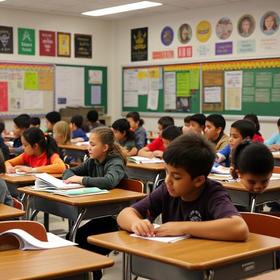With the advent of cell phones, the Internet, MP3 players, DVDs, and more, what should be used in the classroom, and what should be left at the schoolhouse door? Many school administrators, teachers, and parents are pondering this question these days. Like many other complex conundrums, there is no easy answer. There are clear advantages and disadvantages to using new media in the classroom.
If you are a parent, it is up to you to say how much new media should be used in your child’s classroom. The prevalence of both benefits and disadvantages warrants finding the right balance of media in the context of learning.
This video discusses the pros and cons of using technology in the classroom
Learning Advantages of New Media
Less than 30 years ago, fewer than half the households in the United States owned a personal computer, and the Internet was still primarily used by scientists to share information.
Today, the “new media” of learning has leaped off the pages of books and onto the web pages online. For example, volumes of encyclopedias are becoming more obsolete, as this knowledge is easily accessible through the internet and CD-ROMs. Elementary school children are learning to use new media more fluently than their parents, with applications ranging from PowerPoint to Excel. Subsequently, with the potential for learning enclosed in new media, these technologies have found a place in the classroom. While some may deride this trend, there are several advantages to using technology at school.
This TED Talk looks at the massive role technology can play in the classroom.
Most kids learn to read relatively quickly. Granted, some students find it more challenging than others, but, for the most part, children have mastered the basic principles of reading by the time they are five years old, six at the latest. But that is just books.
There are many other “texts” to read in this new age. Although the texts may differ, the idea behind reading them is the same: decoding. In either case—books or new media—if you can teach a child to break down the information into manageable pieces and then process it, you can teach a child to read.
With that in mind, it is possible to teach children how to read books and movies, television shows, commercials, and other “new media” texts. You can show them how to break down or decode all the information thrown at them. In today’s highly commercialized world, showing kids how to process all the advertisements aimed at them is a massive advantage to them. Theoretically, they will now be armed against these constant ads and be better prepared to ward off their influences – all because they were taught how to read “new media” in the classroom.
Similarly, some of the earliest books we learn to read, either with our parents or by ourselves, involve stories with morals. Some are Aesop’s fables, some are classic fairy tales, and others may come from the Bible or a similar holy book. By the end of those books, though, we realize what we are supposed to have learned. Imagine if a child can do that with a movie he has seen. Or a television show. Or a commercial. The growth potential is astronomical. Now, everything can be a learning tool. It is clear how that can be an advantage to anyone, not just a child. However, children may have an easier time grasping the concept because they learn how to read “new media” programs at school.
Using “new media” in the classroom can be a very positive experience for all involved. However, it also has some disadvantages.
Disadvantages of Technology in the Classroom
The biggest setback to using technology in the classroom is how it is used, not if it is used.
If television or movies are used instead of textbooks, novels, or poems, students will not learn how to read as effectively. Study after study has shown that using new media is not a horrible tool to assist in teaching, but that using these media as a primary resource takes away from students the ability to develop their imagination and creative thinking. That, of course, goes against the very goals of teaching. If this becomes commonplace, perhaps the teacher is using “new media” as the primary tool in the classroom because it is easier to set up or requires less planning, and the long-term effects on the students can be troublesome.
This video looks at the disadvantages of using technology in the classroom.
For example, many students have decreased scores in language arts because of overexposure to visual media. These lower scores result from students not knowing how to use or read a text correctly, and if they do not, they will be unable to write properly, spell correctly, or know how to extract information from the text successfully. That, too, goes against the most basic principles of teaching, and it signals a disturbing disadvantage to using “new media” in the classroom.
Conclusion
Our world is constantly changing, and the adage, “The only constant force in the universe is change,” still holds true.
Often, it seems like the majority of that change happens in our schools first. Students today have more resources available to them than many of us never dreamed possible. Most of those resources can be used for good and help students learn and grow. However, some can harm students, and it is essential to balance innovation and conventionality. When used appropriately, the advantages can be taken advantage of while the disadvantages are mitigated.
Questions? Contact us on Facebook. @publicschoolreview














